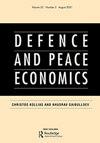International Transmission of Fiscal News Shock: Evidence from Defense Spending
IF 1.6
3区 经济学
Q2 ECONOMICS
引用次数: 0
Abstract
ABSTRACTThis paper proposes a novel fiscal news shock transmission channel from the US to Canada. The US and Canada have a long history of strong political and economic ties. This high degree of economic and political interdependence between Canada and the US makes the Canadian economy sensitive to policy changes in the US. We demonstrate that a fiscal news shock originating from a significant increase in US defense spending can directly transmit to Canada through enhanced defense spending in Canada. We construct a transmission model containing the defense spending news variable to assess the transmission of a fiscal news shock through this novel channel. Our findings suggest that news about increased US defense spending induces Canadian defense spending to rise. Consequently, this increased defense spending has a positive impact on the Canadian GDP. The estimated international fiscal multiplier for Canada is 0.11. We coin a novel fiscal multiplier labeled as the international defense multiplier, which quantifies the response of defense spending of a country due to a change in defense spending in another country.KEYWORDS: Fiscal policynews shockdefense spendingdefense multipliershock transmissionJEL CLASSIFICATION: E62F4H56 AcknowledgmentsThe useful comments and constructive suggestions by two anonymous referees are gratefully acknowledged. The usual disclaimer applies.Disclosure statementNo potential conflict of interest was reported by the author(s).Notes1. There are some limitations of the Granger causality test. Especially in a bivariate model like ours, it may be problematic if both variables are driven by a common third process with different lags. The Granger causality tests are designed to handle pairs of variables and may produce misleading results when the true relationship involves three or more variables. However, this test is used in this paper only to motivate the investigation of the transmission of the defense spending news shock rather than the surprise shock from the US to Canada.2. Some of the variables (such as the narrative series of tax change from Romer and Romer (2010), tax changes series from Mertens and Ravn (2012), and the data on excess returns of military contractors) that are used to extract the US defense spending news shock are available until 2007. Therefore, the US defense spending news shock series cannot be extended after 2007 and as a result, we have to limit the sample of this study to 2007.财政新闻冲击的国际传播:来自国防开支的证据
摘要本文提出了一种新的从美国到加拿大的财政新闻冲击传播渠道。美国和加拿大有着悠久的政治和经济关系。加拿大和美国之间高度的经济和政治相互依赖使得加拿大经济对美国的政策变化非常敏感。我们证明,由美国国防开支大幅增加引起的财政新闻冲击可以通过加拿大国防开支的增加直接传递到加拿大。我们构建了一个包含国防开支新闻变量的传导模型,以评估财政新闻冲击通过这一新颖渠道的传导。我们的研究结果表明,有关美国国防开支增加的新闻导致加拿大国防开支上升。因此,增加的国防开支对加拿大的GDP有积极的影响。加拿大的国际财政乘数估计为0.11。我们创造了一个新的财政乘数,称为国际国防乘数,它量化了一个国家的国防开支对另一个国家国防开支变化的反应。关键词:财政政策新闻冲击国防开支国防乘数冲击传递jel分类:E62F4H56致谢感谢两位匿名审稿人提出的有益意见和建设性建议。通常的免责声明适用。披露声明作者未报告潜在的利益冲突。格兰杰因果检验有一定的局限性。特别是在像我们这样的双变量模型中,如果两个变量都由具有不同滞后的共同第三个过程驱动,则可能会出现问题。格兰杰因果检验的目的是处理成对的变量,当真正的关系涉及三个或更多的变量时,可能会产生误导性的结果。然而,本文使用这个检验只是为了激发对国防开支新闻冲击的传播的研究,而不是为了激发对美国到加拿大的意外冲击的研究。用于提取美国国防开支新闻冲击的一些变量(例如Romer和Romer(2010)的税收变化叙事系列,Mertens和Ravn(2012)的税收变化系列以及军事承包商超额回报的数据)直到2007年都是可用的。因此,美国国防开支新闻冲击系列不能延续到2007年以后,因此,我们不得不将本研究的样本限制在2007年。
本文章由计算机程序翻译,如有差异,请以英文原文为准。
求助全文
约1分钟内获得全文
求助全文
来源期刊

Defence and Peace Economics
ECONOMICS-
CiteScore
4.00
自引率
18.80%
发文量
45
期刊介绍:
Defence and Peace Economics embraces all aspects of the economics of defence, disarmament, conversion and peace. Examples include the study of alliances and burden-sharing; military spending in developed and developing nations; arms races; terrorism; country surveys; the impact of disarmament on employment and unemployment; the prospects for conversion and the role of public policy in assisting the transition; the costs and benefits of arms control regimes; the arms trade; economic sanctions; the role of the United Nations.
 求助内容:
求助内容: 应助结果提醒方式:
应助结果提醒方式:


